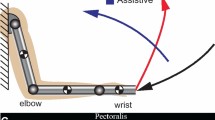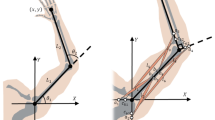Abstract
An integrated, sensorimotor virtual arm (VA) model has been developed and validated for simulation studies of control of human arm movements. Realistic anatomical features of shoulder, elbow and forearm joints were captured with a graphic modeling environment, SIMM. The model included 15 musculotendon elements acting at the shoulder, elbow and forearm. Muscle actions on joints were evaluated by SIMM generated moment arms that were matched to experimentally measured profiles. The Virtual MuscleTM (VM) model contained appropriate admixture of slow and fast twitch fibers with realistic physiological properties for force production. A realistic spindle model was embedded in each VM with inputs of fascicle length, gamma static (γstat) and dynamic (γdyn) controls and outputs of primary (Ia) and secondary (II) afferents. A piecewise linear model of Golgi Tendon Organ (GTO) represented the ensemble sampling (Ib) of the total muscle force at the tendon. All model components were integrated into a Simulink block using a special software tool. The complete VA model was validated with open-loop simulation at discrete hand positions within the full range of α and γ drives to extrafusal and intrafusal muscle fibers. The model behaviors were consistent with a wide variety of physiological phenomena. Spindle afferents were effectively modulated by fusimotor drives and hand positions of the arm. These simulations validated the VA model as a computational tool for studying arm movement control. The VA model is available to researchers at website http://pt.usc.edu/cel.









Similar content being viewed by others
References
Abend W., Bizzi E., Morasso P. 1982 Human arm trajectory formation. Brain 105: 331–348
Alstermark, B., N. Lan, and L.-G. Pettersson. Building a realistic neuronal model that simulates multi-joint arm and hand movements in 3D-space. HFSP Journal 1(4):209–214, 2007
Blemker S. S., Delp S. L. 2005 Three-dimensional representation of complex muscle architectures and geometries. Ann. Biomed. Eng. 33: 661–673
Brown I. E., Cheng E. J., Loeb G. E. 1999 Measured and modeled properties of mammalian skeletal muscle. II. The effects of stimulus frequency on force–length and force–velocity relationships. J. Muscle Res. Cell Motil. 20: 627–643
Brown I. E., Loeb G. E. 1999 Measured and modeled properties of mammalian skeletal muscle. I. The effects of post-activation potentiation on the time course and velocity dependencies of force production. J. Muscle Res. Cell Motil. 20: 443–456
Brown I. E., Loeb G. E. 2000 Measured and modeled properties of mammalian skeletal muscle: III. The effects of stimulus frequency on stretch-induced force enhancement and shortening-induced force depression. J. Muscle Res. Cell Motil. 21: 21–31
Brown I. E., Loeb G. E. 2000 Measured and modeled properties of mammalian skeletal muscle: IV. Dynamics of activation and deactivation. J. Muscle Res. Cell Motil. 21: 33–47
Burdet E., Osu R., Franklin D. W., Milner T. E., Kawato M. 2001 The central nervous system stabilizes unstable dynamics by learning optimal impedance. Nature 414: 446–449
Capaday C., Cooke J. D. 1983 Vibration-induced changes in movement-related EMG activity in humans. Exp. Brain Res. 52: 139–146
Cheng E. J., Brown I. E., Loeb G. E. 2000 Virtual muscle: a computational approach to understanding the effects of muscle properties on motor control. J. Neurosci. Methods 101: 117–130
Cordo P. J., Flores-Vieira C., Verschueren S. M. P., Inglis J. T., Gurfinkel V. 2002 Position sensitivity of human muscle spindles: single afferent and population representations. J. Neurophysiol. 87: 1186–1195
Cordo P., Gandevia S. C., Hales J. P., Burke D., Laird G. 1993 Force and displacement-controlled tendon vibration in humans. Electroen. Clin. Neurophysiol. 89: 45–53
Crago P. E., Houk J. C., Rymer W. Z. 1982 Sampling of total muscle force by tendon organs. J. Neurophysiol. (Bethesda) 47: 1069–1083
Davoodi, R., I. E. Brown, N. Lan, M. Mileusnic, and G. E. Loeb. An integrated package of neuromusculo-skeletal modeling tools in SimulinkTM. In: 23rd IEEE/EMBS Ann Int’l Conf 2001
Delp S. L., Loan J. P. 1995 A graphics-based software system to develop and analyze models of musculoskeletal structures. Comput. Biol. Med. 25: 21–34
Flash T. 1987 The control of hand equilibrium trajectories in multijoint arm movements. Biol. Cybern. 57: 257–274
Garner B. A., Pandy M. G. 2001 Musculoskeletal model of the upper limb based on the visible human male dataset. Comput. Methods Biomech. Biomed. Eng. 4: 93–126
Garner B. A., Pandy M. G. 2003 Estimation of musculotendon properties in the human upper limb. Ann. Biomed. Eng. 31: 207–220
Ghez C., Gordon J., Ghilardi M. F., Christakos C. N., Cooper S. E. 1990 Roles of proprioceptive input in the programming of arm trajectories. Cold Spring Harb. Symp. Quant. Biol. 55: 837–847
Gonzalez R. V., Hutchins E. L., Barr R. E., Abraham L. D. 1996 Development and evaluation of a musculoskeletal model of the elbow joint complex. J. Biomech. Eng. Trans. ASME 118: 32–40
Gordon J., Ghilardi M. F., Ghez C. 1995 Impairments of reaching movements in patients without proprioception. 1. Spatial Errors J. Neurophysiol. 73, 347–360
Haugstvedt J. R., Berger R. A., Berglund L. J. 2001 A mechanical study of the moment-forces of the supinators and pronators of the forearm. Acta Orthop. Scand. 72: 629–634
Hogan N. 1985 The mechanics of multi-joint posture and movement control. Biol. Cybern. 52: 315–332
Holzbaur K. R. S., Murray W. M., Delp S. L. 2005 A model of the upper extremity for simulating musculoskeletal surgery and analyzing neuromuscular control. Ann. Biomed. Eng. 33: 829–840
Johnson M. A., Polgar J., Weightman D., Appleton D. 1973 Data on the distribution of fibre types in 36 human muscles, an autopsy study. J. Neurol. Sci. 18: 111–129
Kuechle D. K., Newman S. R., Itoi E., Morrey B. F., An K. N. 1997 Shoulder muscle moment arms during horizontal flexion and elevation. J. Shoulder Elb. Surg. 6: 429–439
Lan N. 1997 Analysis of an optimal control model of multi-joint arm movements. Biol. Cybern. 76: 107–117
Lan, N., and L. Baker. Biomechanical couplings between elbow and forearm movements. In: Proc. 26th IEEE/EMBS Ann. Intl. Conf., San Francisco, CA, Sept. 2004
Lan N., Crago P. E. 1994 Optimal-control of antagonistic muscle-stiffness during voluntary movements. Biol. Cybern. 71: 123–135
Lan N., Li Y., Sun Y., Yang F. S. 2005 Reflex regulation of antagonist muscles for control of joint equilibrium position. IEEE Trans. Neural Syst. Rehabil. Eng. 13, 60–71
Lan, N., and T. Murakata. A realistic human elbow model for dynamic simulation. In: Proc. 25th Ann. Meeting ASB, San Diego, CA, pp. 267–268, August, 2001
Lan, N., D. Song, and J. Gordon. Systems engineering approach to computational sensorimotor control. In: 28th International Symposium of Computational Neuroscience. Montréal, Canada, 2006
Langenderfer J., Jerabek S. A., Thangamani V. I., Kuhn J. E., Hughes R. E. 2004 Musculoskeletal parameters of muscles crossing the shoulder and elbow and the effect of sarcomere length sample size on estimation of optimal muscle length. Clin. Biomech. 19: 664–670
Lemay M. A., Crago P. E. 1996 A dynamic model for simulating movements of the elbow, forearm, and wrist. J. Biomech. 29(10):1319–1330
Lin C. C. K., Crago P. E. 2002 Structural model of the muscle spindle. Ann. Biomed. Eng. 30: 68–83
Loeb G. E., Brown I. E., Cheng E. J. 1999 A hierarchical foundation for models of sensorimotor control. Exp. Brain Res. 126: 1–18
Mileusnic M. P., Brown I. E., Lan N., Loeb G. E. Mathematical models of proprioceptors: I. Control and transduction in the muscle spindle J. Neurophysiol. 96(4):1772–1788, 2006
Mileusnic M. P., Loeb G. E. Mathematical models of proprioceptors: II. Structure and function of the Golgi tendon organ. J. Neurophysiol. 96(4):1172–1802, 2006
Murray W. M., Buchanan T. S., Delp S. L. 2000 The isometric functional capacity of muscles that cross the elbow. J. Biomech. 33: 943–952
Murray W. M., Delp S. L., Buchanan T. S. 1995 Variation of muscle moment arms with elbow and forearm position. J. Biomech. 28: 513–525
Perreault E. J., Kirsch R. F., Crago P. E. 2002 Voluntary control of static endpoint stiffness during force regulation tasks. J. Neurophysiol. 87: 2808–2816
Schweighofer N., Arbib M. A., Kawato M. 1998 Role of the cerebellum in reaching movements in humans. I. Distributed inverse dynamics control. Eur. J. Neurosci. 10: 86–94
Scott S. H., Loeb G. E. 1994 The computation of position sense from spindles in mono- and multiarticular muscles. J. Neurosci. 14: 7529–7540
Seireg, A., and R. Arvikar. Biomechanical Analysis of the Musculoskeletal Structure for Medicine and Sports. Hemisphere Publishing Corp., p. 93, 1989
Song, D., N. Lan, and J. Gordon. Biomechanical constraints on equilibrium point control of the multi-joint arm. A simulation study, ASB 2007 Conference, Stanford Univ., CA, August 2007
Song, D., M. Mileusnic, N. Lan, and J. Gordon. A sensorimotor systems model for dynamic simulation of arm movement control. In: 16th Annual Neural Control of Movement Meeting. Key biscayn Florida, USA: 2006
Stein R. B., Weber D. J., Aoyagi Y., Prochazka A., Wagenaar J. B. M., Shoham S., Normann R. A. 2004 Coding of position by simultaneously recorded sensory neurones in the cat dorsal root ganglion. J. Physiol. Lond. 560: 883–896
Veeger H. E. J, Yu B., An K. N., Rozendal R. H. 1997 Parameters for modeling the upper extremity. J. Biomech. 30: 647–652
Wood J. E., Meek S. G., Jacobsen S. C. 1989 Quantitation of human shoulder anatomy for prosthetic arm control. 1. Surface modeling. J. Biomech. 22, 273
Wu G., van der Helm F. C. T., Veeger H. E. J., Makhsous M., Van Roy P., Anglin C., Nagels J., Karduna A. R., McQuade K., Wang X. G., Werner F. W., Buchholz B. 2005 ISB recommendation on definitions of joint coordinate systems of various joints for the reporting of human joint motion—Part II: shoulder, elbow, wrist and hand. J. Biomech. 38: 981–992
Yakovenko S., Gritsenko V., Prochazka A. 2004 Contribution of stretch reflexes to locomotor control: a modeling study. Biol. Cybern. 90, 146–155
Zajac F. E. 1989 Muscle and tendon—properties, models, scaling, and application to biomechanics and motor control. Crit. Rev. Biomed. Eng. 17: 359–411
Acknowledgments
The materials of this paper are based on the work supported by a grant from the NSF (IBN-0352117). The authors appreciate the assistance of Mr. Nayar in this project, the useful suggestions from Dr. Mileunsic. The authors wish to thank Dr. Murray for providing elbow muscle moment arm data, and Dr. Davoodi for programming MMS. Part of the shoulder/thorax complex in this model was obtained from Stanford University with permission.
Author information
Authors and Affiliations
Corresponding author
Appendix A
Appendix A
The muscle architectural parameters of each of the 15 muscles in the VA model were tuned step by step as described in Methods, Section “Virtual Muscle Model Parameters”. The physiological constraint for this tuning process is the fascicle length operating range within \( 0.45 \le \ifmmode\expandafter\bar\else\expandafter\=\fi{L}_{{{\text{ce}}}} \le 1 \) (See Fig. 6). At the same time, there has been a wide range of literature reports on muscle peak force (F 0), optimal fascicle length (L ce0), and tendon slack length (L ses). We compared the values of our VM parameters with those of experimental measurements and previous modeling approaches here in Table 5 on F 0, Table 6 on L ce0 and Table 7 on L ses. There is a large variability in the literature on each of the three sets of parameters due to the possible differences in experimental preparations and specimen size.17,18,20,24,33,39 However, our model parameters fall generally within the range of physiological values, and the VA model reproduces the realistic force generating capability of human arm muscles.
Rights and permissions
About this article
Cite this article
Song, D., Lan, N., Loeb, G.E. et al. Model-Based Sensorimotor Integration for Multi-Joint Control: Development of a Virtual Arm Model. Ann Biomed Eng 36, 1033–1048 (2008). https://doi.org/10.1007/s10439-008-9461-8
Received:
Accepted:
Published:
Issue Date:
DOI: https://doi.org/10.1007/s10439-008-9461-8




